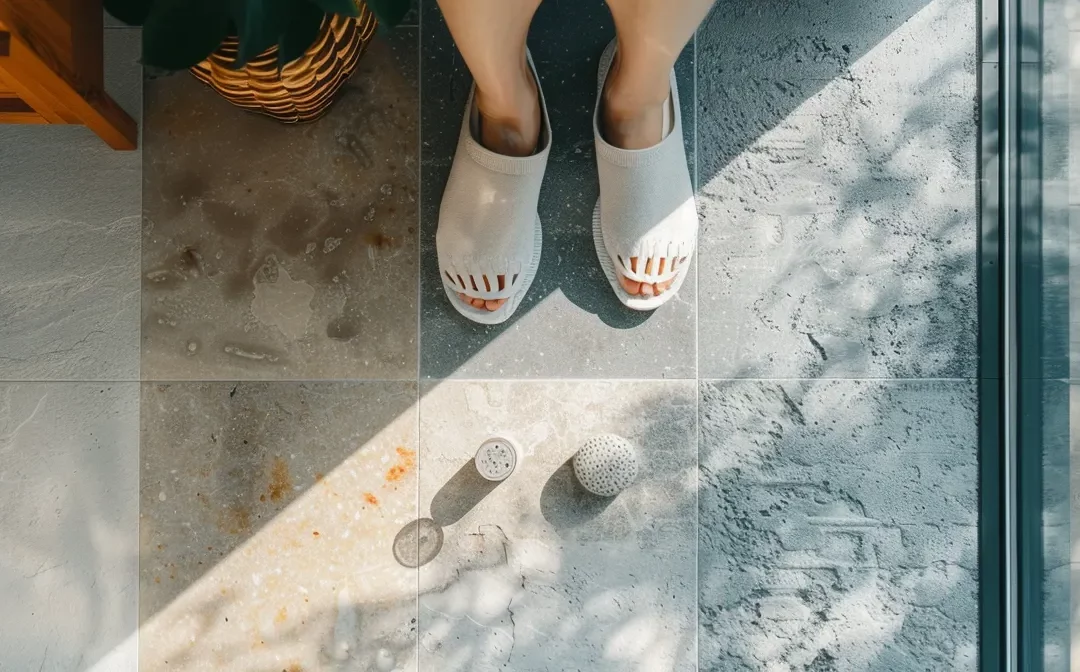Selecting Safe and Stylish Non-Slip Flooring for Your Bathroom
Selecting the right flooring for a bathroom is crucial, particularly when considering the challenges posed by moisture. Bathroom and Kitchen Resurfacing projects often emphasize the importance of safety alongside style, and non-slip options provide an effective solution. Utilizing durable materials, like porcelain tile, enables homeowners to achieve a visually appealing space while maintaining safety standards supported by industry guidelines from Master Builders Australia. Choosing non-slip flooring significantly enhances comfort and security in the bathroom, making it an essential consideration for any renovation. Keep reading to uncover practical ideas and detailed information about selecting the best non-slip flooring options for your bathroom.
Key Takeaways
- Selecting non-slip flooring enhances both safety and aesthetic appeal in bathroom renovations
- Textured tiles, ceramic, and porcelain provide excellent slip resistance for wet areas
- Proper installation and material selection are crucial for maximizing safety and style
- Natural stone options like slate and granite can enhance grip while maintaining elegance
- Adding anti-slip treatments and accessories further improves safety in bathroom environments
Non-Slip Bathroom Flooring Ideas
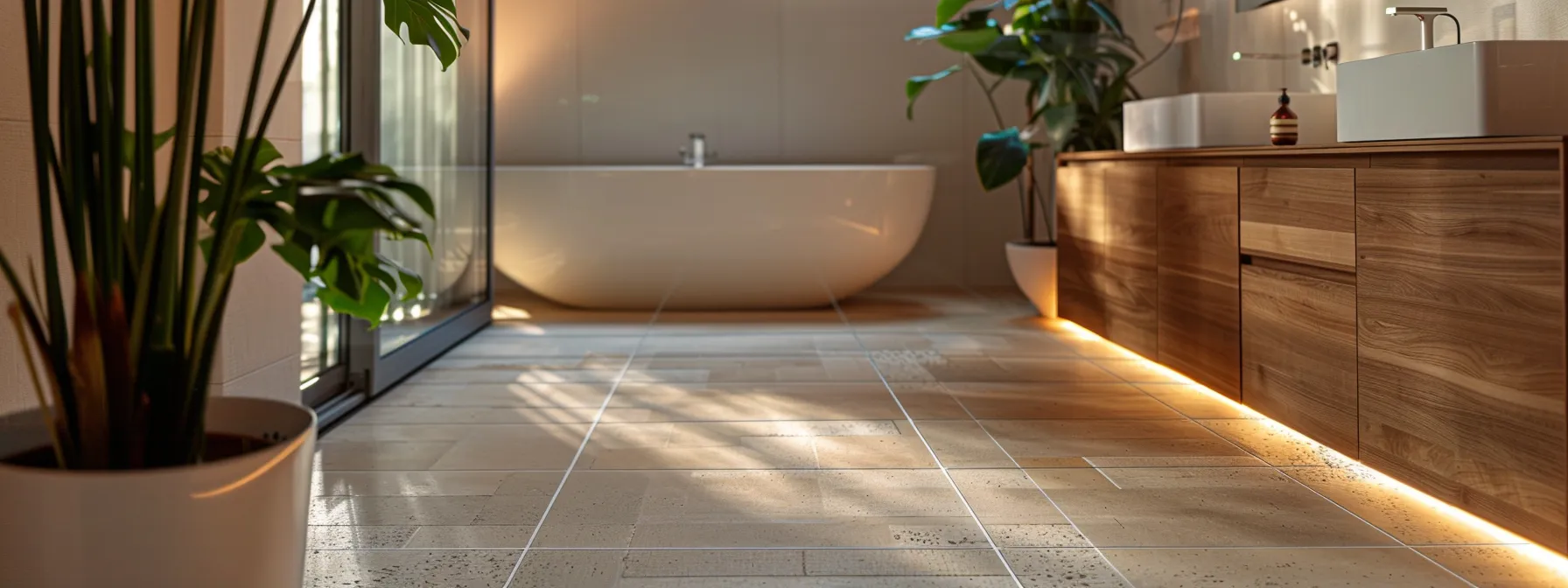
When considering non-slip bathroom flooring, a myriad of material options exists that cater to both safety and style. From textured tiles that mimic the look of natural brick to elegant wood finishes that bring warmth, each choice offers unique benefits. The strategic use of textures can significantly enhance grip, reducing the chance of slips, especially when surfaces become wet from soap or water. Additionally, the Bathroom and Kitchen Resurfacing color and pattern can serve a dual purpose: enhancing the overall aesthetic while providing visibility elements that promote safety. By carefully selecting flooring that complements other features, such as countertops, homeowners can harmonize their spaces while prioritizing functionality. Master Builders Australia
Exploring Various Material Options
When choosing non-slip flooring for a bathroom, several materials stand out for their safety and aesthetic appeal. For instance, linoleum provides a budget-friendly option that sports a naturally textured surface, reducing the risk of slips when transitioning from the bathtub to the rest of the bathroom. Furthermore, homeowners can enhance their bathtub area by applying anti-slip tape for bathtubs, offering an additional layer of safety without compromising the space’s overall style.
Benefits of Textured Surfaces
Textured surfaces in bathroom flooring deliver enhanced safety while also allowing for design flexibility. For instance, ceramic tiles with various surface finishes can significantly improve traction, minimizing slip risks even when flooring is wet from showers or spills. Additionally, applying a non-slip coating can protect these surfaces from stains while further enhancing their grip, making them an excellent choice for homeowners focused on both safety and aesthetics.
- Textured surfaces provide better grip to prevent slips.
- Ceramic tiles with varied finishes add decorative appeal.
- Non-slip coatings enhance safety and protect against stains.
- Mats for shower floors can complement textured options.
- Consideration of all these factors is vital during renovation.
Color and Pattern Choices for Safety and Style
Choosing the right color and pattern enhances both safety and aesthetic appeal in bathroom flooring. A strategic combination of hues can make anti slip for shower floor solutions stand out while also complementing the overall décor. Brands often offer patterned tiles that provide visual interest alongside functionality, and incorporating a suitable underlay can improve safety and comfort beneathfoot.
- Select colors that enhance visibility and safety.
- Patterns can add decorative elements without sacrificing function.
- Consider anti-slip treatments for added security in the shower area.
- Opt for underlay options that improve comfort and grip.
- Research on Houzz for innovative flooring ideas that blend style with safety.
As homeowners consider their options for bathroom renovations, the safety and functionality of flooring cannot be overlooked. Understanding the benefits of non-slip bathroom flooring can elevate both aesthetics and peace of mind in any space.
Why Choose Non-Slip Bathroom Flooring?
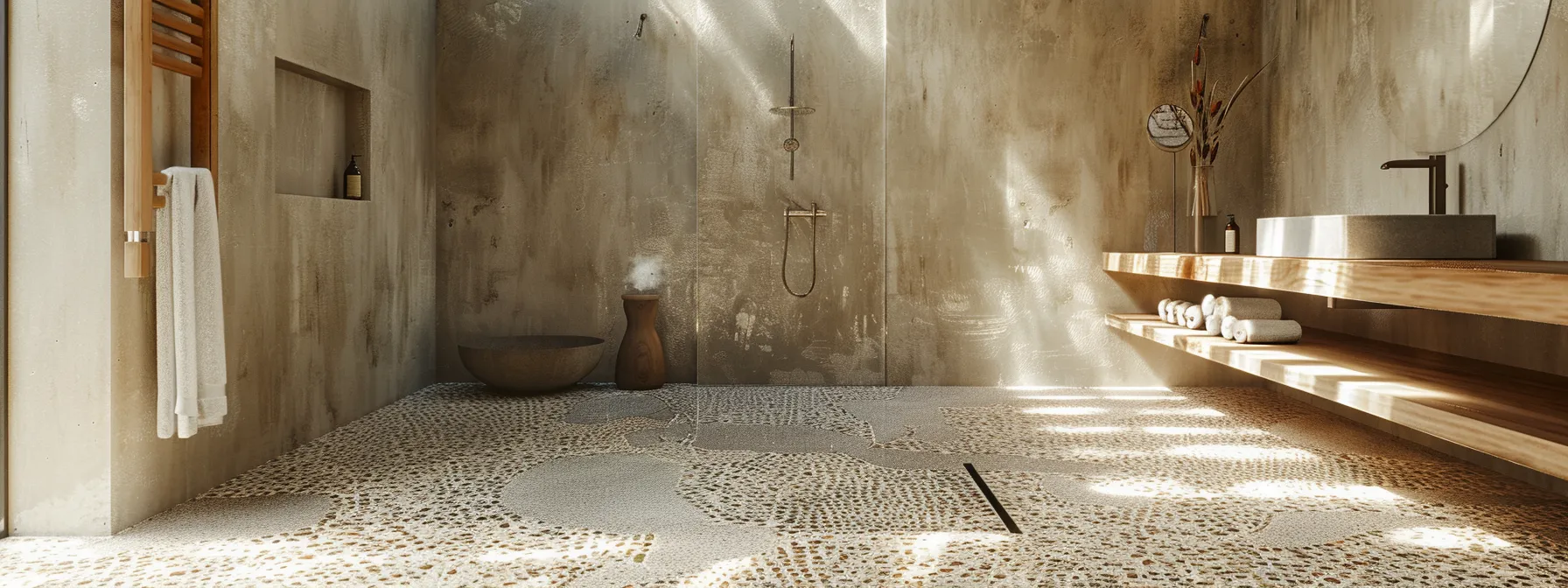
Non-slip bathroom flooring plays a crucial role in maintaining safety, particularly in wet areas where slips and falls are prevalent. Selecting flooring that incorporates features such as non skid for shower floor solutions can greatly reduce the risk of accidents while enhancing the overall aesthetic appeal of the space. Options like mosaic tiles or rubber mats for showers not only offer practical grip but also contribute to a stylish environment. Additionally, alternative materials such as concrete can be expertly designed to provide a sleek look that harmonizes with the room’s décor while ensuring safety is never compromised. Prioritizing both form and function creates a welcoming atmosphere that supports everyday use without worrying about potential hazards.
The Importance of Safety in Wet Areas
In wet areas, such as bathrooms, the need for safety surfaces cannot be overstated. Flooring materials that offer shower floor grip are essential to prevent slips, particularly in spaces where water and oil may accumulate. Additionally, utilizing rubber backed bath mats not only enhances interior design but also provides extra traction, reducing the risk of falls, especially near stairs where accidents can be more severe.
Enhancing Aesthetic Appeal Without Compromising on Safety
Selecting bathroom anti-slip floor tiles that blend safety and style is essential for any renovation project. Engineered wood offers a warm aesthetic, while also providing a durable surface that can withstand water damage. Pairing these tiles with non-skid bathroom floor mats further enhances safety, ensuring that the space remains both functional and visually appealing.
Exploring the benefits of non-slip bathroom flooring opens the door to a safer and more stylish space. Now, let’s uncover the types of tiles that provide traction and peace of mind even in the wettest conditions.
What Kind of Tile Is Not Slippery When Wet?
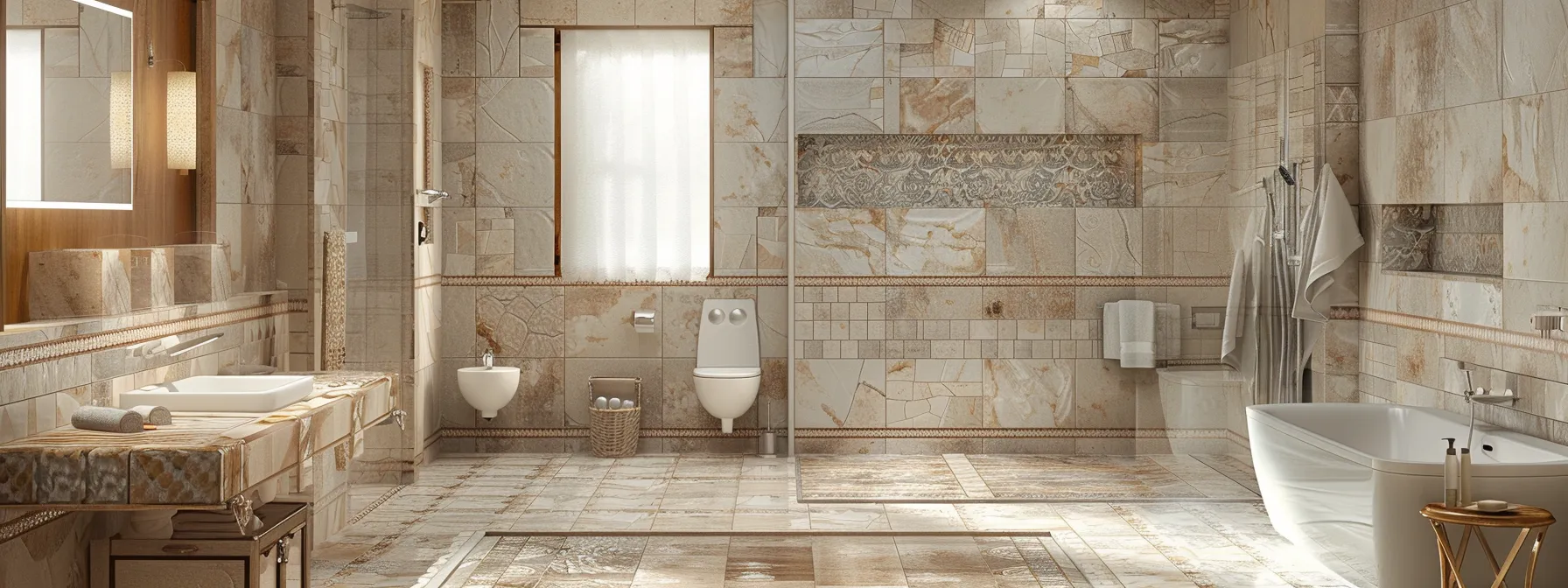
When selecting non-slip tiles for a bathroom, understanding the differences between ceramic and porcelain options is key to enhancing safety. While both types offer various finishes that can provide traction, their durability and moisture resistance vary. Evaluating stone tiles such as marble and granite also plays a significant role, as their natural textures can contribute to slip resistance. Furthermore, while wood flooring adds warmth to bathroom aesthetics, it often requires special adhesives and treatments to ensure safety in wet environments. Considering these materials helps homeowners make informed decisions that balance style with essential safety features.
Ceramic vs. Porcelain Tiles for Slip Resistance
Ceramic and porcelain tiles provide effective options for non-slip flooring, particularly in wet areas like bathrooms. Ceramic tiles generally have a rougher texture, allowing for better friction when wet, while porcelain tiles are denser and also resist moisture effectively. Homeowners can further enhance safety by complementing these tiles with rubber bathtub mats, which add an extra layer of protection without detracting from the beauty of the space.
Additionally, applying an epoxy coating to either tile type can boost slip resistance while prolonging the life of the floor. This approach not only maintains the flooring’s aesthetic appeal but also addresses safety concerns effectively. Selecting the right floor coverings and accessories serves to support a stylish and functional bathroom environment.
Evaluating Stone Tiles for Bathroom Safety
When selecting stone tiles for bathroom flooring, considerations of safety and hygiene are paramount. Slate tiles, known for their natural slip resistance, offer not only a stylish option but also a surface that resists mold growth, enhancing overall hygiene in wet environments. In contrast, while porcelain tiles can also provide functionality, their smooth surfaces may require additional treatments to improve grip, making it essential for homeowners to evaluate their choices fully before installation.
Choosing the right tile can significantly enhance safety in wet areas, but why stop at just that? Upgrade your space by investing in a virtually indestructible floor that combines style and durability for lasting peace of mind.
Invest in a Virtually Indestructible Floor
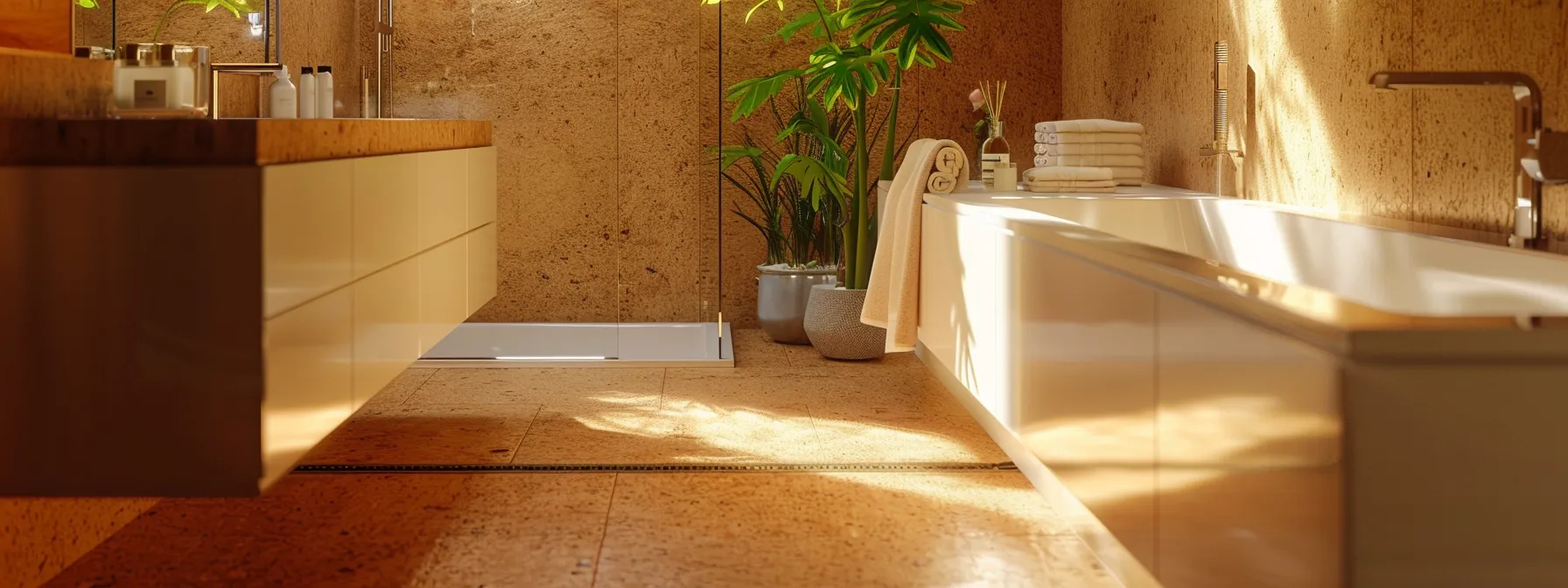
Investing in a virtually indestructible floor is crucial for maintaining both safety and aesthetic appeal in bathrooms. Homeowners can choose from a variety of resilient materials, each offering unique characteristics that cater to durability and slip resistance. Cork stands out for its ability to absorb impact and provide a soft underfoot experience, while hardwood exudes elegance and warmth. On the other hand, laminate flooring offers a budget-friendly option that mimics the appearance of wood, making it suitable for various spaces, including dining rooms. Evaluating these materials helps homeowners achieve a surface that withstands daily use and significantly reduces the risk of slip and fall incidents, thereby enhancing overall safety in wet environments.
Materials That Stand the Test of Time
Bamboo flooring is becoming a popular choice for bathrooms due to its inherent moisture resistance and environmental benefits. This material not only withstands daily wear and tear but also minimizes the risk of mold growth when properly sealed. Additionally, using tile with a robust grout can enhance longevity while offering aesthetic appeal, ensuring the flooring remains functional even in high-traffic wet areas.
- Bamboo provides moisture resistance and eco-friendliness.
- Tile with strong grout enhances durability and aesthetics.
- Choosing the right materials reduces the risk of slips and falls.
Comparing Durability and Slip Resistance
When evaluating flooring options, it is essential to balance durability with slip resistance, especially in a bathroom setting. Materials such as vinyl and rubber offer robust resistance against wear while maintaining a textured surface to reduce slip hazards. While natural stone provides an appealing aesthetic, ensuring it meets slip-resistant standards is crucial to maintain safety in wet conditions.
Selecting the right flooring involves a thoughtful assessment of these factors, as the goal is to create a safe yet visually appealing environment that can withstand daily use.
A virtually indestructible floor offers unmatched durability, but it’s essential to consider safety as well. Selecting a non-slip porcelain option elevates both style and security, ensuring a beautiful yet safe environment.
Choose a Non-Slip Porcelain Option
Porcelain flooring emerges as an optimal choice for bathrooms due to its combination of exceptional durability and inherent slip resistance. Recognized for its dense, non-porous surface, porcelain effectively withstands moisture and is less prone to staining, making it ideal for wet environments. The installation process plays a crucial role in enhancing both safety and aesthetics; strategic pattern placement and an appropriate grout choice can maximize traction while creating a visually appealing layout. By selecting porcelain, homeowners invest in a stylish solution that ensures a safe bathroom experience.
Why Porcelain Tops the List for Bathrooms
Porcelain flooring stands out as a prime selection for bathrooms, primarily due to its exceptional durability and water resistance. This type of tile not only withstands moisture but also resists staining, making it well-suited for the demanding environment of a bathroom. Additionally, porcelain tiles come in various textures and finishes, allowing homeowners to achieve a safe yet stylish look that enhances the overall design of the space.
Consider the following benefits of choosing porcelain for your bathroom flooring:
- Outstanding water resistance that minimizes damage risk.
- Varied textures enhance slip resistance while maintaining elegance.
- Low maintenance requirements ensure long-lasting appeal.
Installing for Maximum Safety and Style
Proper installation of non-slip porcelain flooring is vital for achieving optimal safety and visual appeal in bathrooms. Professional installers ensure that tiles are laid with precise alignment and appropriate adhesive, maximizing both grip and stability. By carefully selecting grout colors and finishes, homeowners can enhance the flooring’s aesthetic while maintaining its slip-resistant qualities, creating a harmonious connection between safety and style.
After selecting a non-slip porcelain option, homeowners can elevate their space further with a stunning and robust stone choice. This shift not only enhances aesthetics but also promises lasting durability that stands the test of time.
Go for a Durable Stone
Natural stone flooring presents an appealing option for bathroom environments, balancing aesthetic charm with functional benefits. Understanding the advantages and disadvantages of natural stone in wet areas is essential for homeowners looking to enhance safety while maintaining style. Certain stones, such as slate and textured granite, offer superior grip and slip resistance, making them ideal for bathrooms. Conversely, some natural stones may require additional treatments to improve traction in wet conditions. Evaluating the best stone choices for non-slip properties ensures that homeowners achieve a safe and visually appealing space that stands up to the demands of daily use.
Pros and Cons of Natural Stone in Wet Environments
Natural stone flooring offers a unique blend of elegance and functionality, yet its use in wet environments comes with careful considerations. While stones like slate and textured granite provide excellent slip resistance due to their natural grip, others may require additional treatments to enhance safety in moisture-prone areas. Homeowners must weigh these factors against the aesthetic appeal and durability that natural stone can bring to their bathrooms, ensuring a balance between style and safety.
Best Stone Choices for Non-Slip Properties
Homeowners seeking reliable non-slip stone options for their bathrooms can consider materials such as slate, textured granite, and quartzite. These stones not only provide natural resistance to slips but also add aesthetic appeal and elegance to the space. Proper selection and treatment of these stones ensure durability and safety in high-moisture environments.
